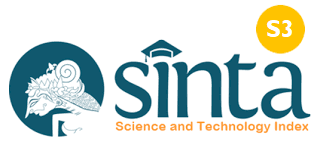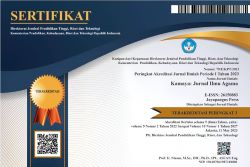Upaya Mitigasi Spiritual Dalam Menyikapi Pandemi Corona Virus Diseases (Covid-19) Menurut Lontar Roga Sanghara Bhumi
DOI:
https://doi.org/10.37329/kamaya.v4i3.1384Keywords:
Spiritual Mitigation, Pandemic, Corona Virus Diseases (Covid-19), Lontar Roga Sanghara BhumiAbstract
The phenomenon of the Corona Virus Diseases (Covid-19) Pandemic that has occurred in all corners of the world has made the world's internal situation very worrying. However, if you are willing to look back at your historical track record, situations similar to the Covid-19 pandemic have actually been experienced by the world, such as SARS-Coronavirus and MERS-Coronavirus. All of these phenomena have been studied in medical laboratories, but what is very rarely done is an assessment based on existing historical records or data, as in classical Lontar literature as in Lontar Roga Sanghara Bhumi. Three issues were raised in this study: regarding the structure of the text, classifying the Covid-19 pandemic disaster from the Lontar Roga Sanghara Bhumi study and spiritual mitigation efforts in responding to the Covid-19 pandemic disaster from the Lontar Roga Sanghara Bhumi study. This type of research is a qualitative research with a psychological approach. The data obtained were collected using library techniques and document recording. The data that has been collected is then analyzed with qualitative descriptive techniques and hermeneutics. The results of this study indicate that the content structure is structured in the format of formal structure (manggala, corpus, epilogue, language) and narrative structure (theme and aspects of speech). If classified, the Covid-19 disaster in the text of Lontar Roga Sanghara Bhumi is included in a Non-Natural Disaster, which is categorized as a Grubug Agung phenomenon or a pandemic outbreak on a wide scale. There are several spiritual mitigation efforts in responding to Covid-19 according to Lontar Roga Sanghara Bhumi, including; (1) Preventive Efforts, in the form of spiritual-based isolation and social distancing efforts, drawing closer to God and fortifying oneself with spiritual means, (2) Curative Efforts, in the form of alternative treatments with tattwa and spiritual ethics as well as through ritual means (yajña), and (3) Promotive Efforts, in the form of suggestions to deepen the knowledge of God, ethics and morality, yaja and deepen the knowledge of usada
References
Abbas, S. (2014) Perbedaan Sistem Pengobatan Medis dan Non Medis, Sirouzs Wordpress. Available at: https://sirouzs.wordpress.com/2014/05/31/perbedaan-sistem-pengobatan-medis-dan-non-medis/.
Artadi, I. K. (2011) Kebudayaan Spiritualitas; Nilai Makna dan Martabat Kebudayaan; Dimensi Tubuh Akal Roh dan Jiwa. 2nd edn. Denpasar: Pustaka Bali Post.
Artajaya, G. S. (2020) ‘The COVID-19 Pandemic Perspective Of Religious Literature Studies In Bali’, Widyadari, 21, pp. 652–664. Available at: https://ojs.mahadewa.ac.id/index.php/widyadari/ article/view/914/745.
Casman et al. (2020) ‘Studi Literatur: Penolakan Jenazah Covid-19 Di Indonesia’, Jurnal Kesehatan Manarang, 6, pp. 18–26. Available at: http://webcache.googleusercontent. com/search?q=cache:dQwDFTYQYeMJ:jurnal.poltekkesmamuju.ac.id/index.php/m/article/download/283/115+&cd=23&hl=id&ct=clnk&gl=id.
Corman, V. M. et al. (2020) ‘Detection Of 2019 Novel Coronavirus (2019-nCoV) by real time RT-PCR’, Eurosurvillance, 3, pp. 23–30. Available at: https://www.eurosurveillance.org/content/ 10.2807/1560-7917.ES.2020.25.3.2000045.
Departemen Pendidikan Nasional (2008) Kamus Besar Bahasa Indonesia Pusat Bahasa. Jakarta: Gramedia Pustaka Utama.
Endraswara, S. (2008) Metodologi Penelitian Sastra. Yogyakarta: MedPress.
Hasan, I. (2002) Metodologi Penelitian dan Aplikasinya. Jakarta: Ghalia Indonesia.
Howard, R. . (2000) Hermeneutika, Wacana Analisis, Psikososial & Ontologis. Bandung: Nuansa.
Huang, C. et al. (2020) ‘Clinical features of patients infected with 2019 novel coronavirus in Wuhan, China’, The Lancet, 395, pp. 497–506. doi: https://doi.org/10.1016/S0140-6736(20)30183-5.
Hunston, S. (2002) Corpora and Applied Linguistics. Cambridge: Cambridge University Press. Available at: https://www.researchgate.net/publication/31494773_Corpora_in_Applied_ Linguistics.
Jauhari, H. (2010) Panduan Penulisan Skripsi Teori Dan Aplikasi. Bandung: Pustaka Setia.
Juanamasta, I. G., Ni Made Nopita Wati and Anak Agung Gede Oka Widana (2020) ‘COVID-19: A Balinese Viewpoint’, Belitung Nursing Journal, 6(4). doi: https://doi.org/10.33546/bnj.1133.
Kotler, P. and Keller, K. L. (2006) Marketing Management 12th edition. New Jersey: Pearson Education Inc.
Kresna, A. and Ahyar, J. (2020) ‘Pengaruh Physical Distancing Dan Social Distancing Terhadap Kesehatan Dalam Pendekatan Linguistik’, Jurnal Syntax Transformation, 1, pp. 14–19. Available at: https://media.neliti.com/media/publications/ 329984-pengaruh-physical-distancing-dan-social-d30f26cd.pdf.
Maharsi (2009) Kamus Jawa Kawi-Indonesia. Yogyakarta: Pura Pustaka.
Moleong, L. J. (2010) Metodologi Penelitian Kualitatif. Bandung: Remaja Rosdakarya.
Padila (2013) Buku Ajar Keperawatan Gerontik. Yogyakarta: Nuha Medika.
Paramita, I. G. A. (2018) ‘Bencana, Agama dan Kearifan Lokal’, Dharmasmrti, 1, pp. 36–44. Available at: https://media.neliti.com/media/publications/266362-bencana-agama-dan-kearifan-lokal-a4a04ce9.pdf.
Pidada, J. S. (2018) ‘Satyam, Sivam, Sundaram’, Wartam Majalah Pengemban Dharma, p. 4.
Purnami, I. A. P. (2019) ‘Pelestarian Kearifan Lokal Bali Melalui Konservasi Naskah Lontar’, Prasi, 14, pp. 1–12. doi: http://dx.doi.org/10.23887/prasi.v14i1.17894.g10701.
Ratna, I. N. K. (2009) Stilistika: Kajian Puitika Bahasa, Sastra dan Budaya. Yogyakarta: Pustaka Pelajar.
Semi, A. (1993) Anatomi Sastra. Bandung: Angkasa.
Strauss, A. & and Corbin, J. (1997) Basic of Qualitative Research: Grounded Theory Procedures and Techniques. Surabaya: Bina Ilmu.
Sugihantono, A. et al. (2020) Pedoman Pencegahan dan Pengendalian Coronavirus Disease (COVID-19) Revisi Kelima. 5th edn. Edited by L. Aziza. Jakarta: Kementrian Kesehatan RI.
Sumaryono, E. (1993) Hermeneutik. Sebuah Metode Filsafat. Yogyakarta: Kanisius.
Sutjaja, I. G. M. (2006) Kamus Bali-Indonesia-Inggris. Denpasar: Lotus Widya Suari.
Wang, Z., Qiang, W. and Ke, H. (2020) A Handbook of 2019-nCoV Pneumonia Control and Prevention. Hubei Science and Technologi Press. Available at: http://fpmpam.org/files/ Handbook_2019nCoV.pdf.
Wellek, R. and Warren, A. (1993) Teori Kesusastraan. Jakarta: Gramedia Pustaka Utama.
Wendimagegn, N. F. and Bezuidenhout, M. C. (2019) ‘Integrating promotive, preventive, and curative health care services at hospitals and health centers in Addis Ababa, Ethiopia’, Journal of Multidisciplinary Healthcare, 12, pp. 243–255. doi: 10.2147/JMDH.S193370.
Widana, A. A. G. O. (2020) ‘Ngebug Grubug (Belajar Membangun Solusi Tanpa Terisolasi)’, Majalah Hindu Raditya, No. 273, ISSN 08526982, pp. 36–37.
Downloads
Published
How to Cite
Issue
Section
License
An author who publishes in the Kamaya : Jurnal Ilmu Agama agrees to the following terms:
- Author retains the copyright and grants the journal the right of first publication of the work simultaneously licensed under the Creative Commons Attribution-ShareAlike 4.0 License that allows others to share the work with an acknowledgement of the work's authorship and initial publication in this journal
- Author is able to enter into separate, additional contractual arrangements for the non-exclusive distribution of the journal's published version of the work (e.g., post it to an institutional repository or publish it in a book) with the acknowledgement of its initial publication in this journal.
- Author is permitted and encouraged to post his/her work online (e.g., in institutional repositories or on their website) prior to and during the submission process, as it can lead to productive exchanges, as well as earlier and greater citation of the published work (See The Effect of Open Access).
Read more about the Creative Commons Attribution-ShareAlike 4.0 Licence here: https://creativecommons.org/licenses/by-sa/4.0/.





